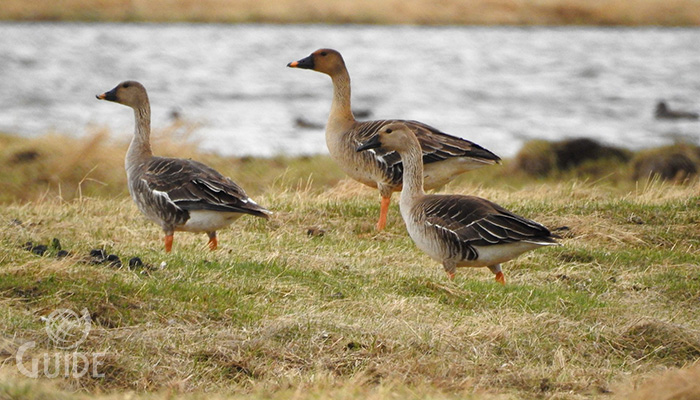
English: Bean
Goose
Russian: Гуменник
German: Saatgans
French: Oie
des moissons
Mongolian: Буурал галуу
Japanese: ヒシクイ(Hishikui)
Body
length: 69-88 cm
Wing
span: 140-174 cm
Passage migrant
Migration: Apr.-May; Aug.-Sep.
Global status: Least concern
Regional status: Least Concern
Habitat: Breeds on bogs, marshes and pools in remote taiga, both wintering
in W and C Europe. Migrants passing S Fenno-Scandia 2nd half
Apr and Sep/Oct. Huge roosting and wintering flocks at favoured places in S
Sweden and N Continental Europe; scarce in Britain, Shy and wary.
Identification: Medium
large, rather dark tertials and upper-wing-coverts. Head and neck rather dark. Differs from
Greylag and Pink-footed in orange (or dull red) legs, not pink; also, in flight
upperwing rather dark, not strikingly pale, and underwing all dark. Sometimes
difficult to separate from Pink-footed, especially at a distance, when orange
of bill and legs often looks indeterminably dull red; back just as dark as
flank area (paler on Pink-footed) helpful, as is narrower white terminal
tail-band of Bean. Many have narrow white rim at base of bill; those with most
can resemble White-fronted Goose.
Ecologically
differentiated subspecies fabalis and rossicus differ slightly but distinctly.
Ssp. fabalis about as large as Greylag but has narrower neck, smaller head,
slimmer bill and body; bill is usually long, and base not too deep; amount of
orange (or dull red) variable, some with dark restricted to base of lower
mandible, tip and a little on culmen, others with a lot of dark at base of bill
resembling rossicus and Pink-footed. Ssp. rossicus
is slightly smaller, has shorter neck, darker head and neck which contrast more
markedly with paler body than in fabalis, all characters which make it more
similar to Pink-footed; bill is short, deep-based and triangular, and pale
(reddish) patch almost invariably small, and base of lower mandible is deeper
and more curved. In large flocks of N Europe some birds appear to be
intermediates.
Food: Short plants and wheat grains